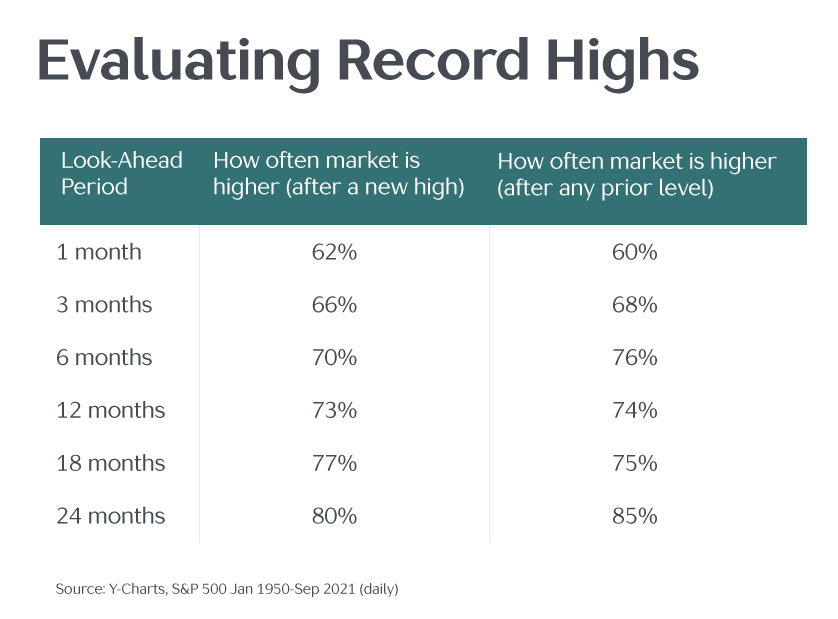If you’ve been reading our Vista viewpoints for a while, you may have accepted the wisdom of staying disciplined during market downturns. But what about when markets seem “overpriced”? Is it safe to stay invested, or even add more money, when markets have been hitting new all-time highs?
With the S&P 500 posting 50 new record highs so far this year, it’s a question many investors are asking. The popular press has a way of aiding and abetting our fixation on seemingly significant milestones, such as when the Dow recently topped 36,000 for the first time. This, in turn, might leave you wondering whether new market highs mean there’s nowhere to go but down.
Up, Up, and Usually Away
If we zoom out to review the historical record, we see a much different story: More often than not, markets keep climbing higher, even after past record highs.
We illustrate this observation in the table below. Using the S&P 500 as a proxy for the U.S. stock market, we identified each new record high over the past 70 years. We then looked forward after each market high to evaluate whether the stock market was higher still at future dates ranging from one month to two years. The results are displayed below the middle column.
On average, the market was higher 62% of the time one month after a record high.
Three months later, on average, the stock market was higher still on 66% of occasions, and higher 70% of the time at the six-month mark. Two years after a record high, the market was higher 80% of the time.
The takeaway? American businesses have continued to find ways to profitably deliver goods and services to a growing population, and stockholders have benefited.

How do these high-water marks compare with other points in time? The third column shows those figures. As you can see, the frequency at which markets have risen after any day chosen at random looks pretty similar to how markets have performed after record highs.
In other words, we see no evidence investors should expect an imminent decline based on high-water marks already achieved.
Go With the Market Flow
This is not to suggest we shouldn’t be prepared for choppy waters. Downturns are part of investing, as well.
We only have to look back at the S&P 500’s remarkable rise over the past decade—a fourfold increase—to know markets don’t simply go up. Indeed, there have been 10 market corrections of 10% or more during this stretch. In other words, a painful, albeit temporary, downturn has occurred every year, on average. We set our expectations, and build portfolios, accordingly.
A Rising Tide Raises All Boats
Let’s remember that stocks aren’t heavy objects to be held high through strenuous effort. There’s no law of gravity for market levels. At its best, stock ownership is a perpetual claim on the earnings and dividends of businesses around the world.
In aggregate and over time, some companies profit and economies grow; others cease to exist, and no longer influence market pricing. Since stock markets are essentially defined by this aggregate performance, overall profits and prices should push markets to ever-higher levels over time, as we have seen.
Odds favor the patient investor who stays globally invested and waits for the river to rise. By trying to time when to dive in and out of rising, falling, and resurging markets, you’re far more likely to sink than swim.
